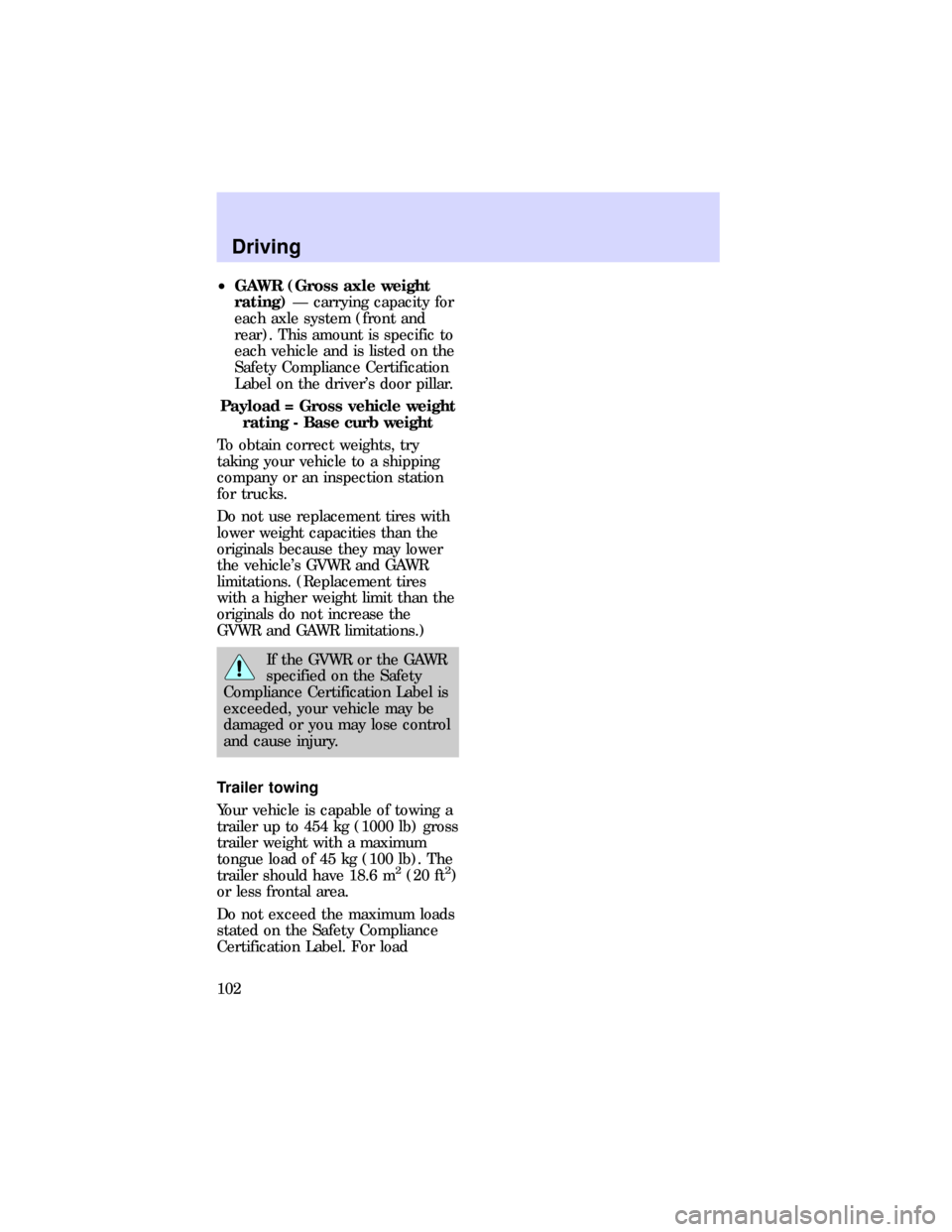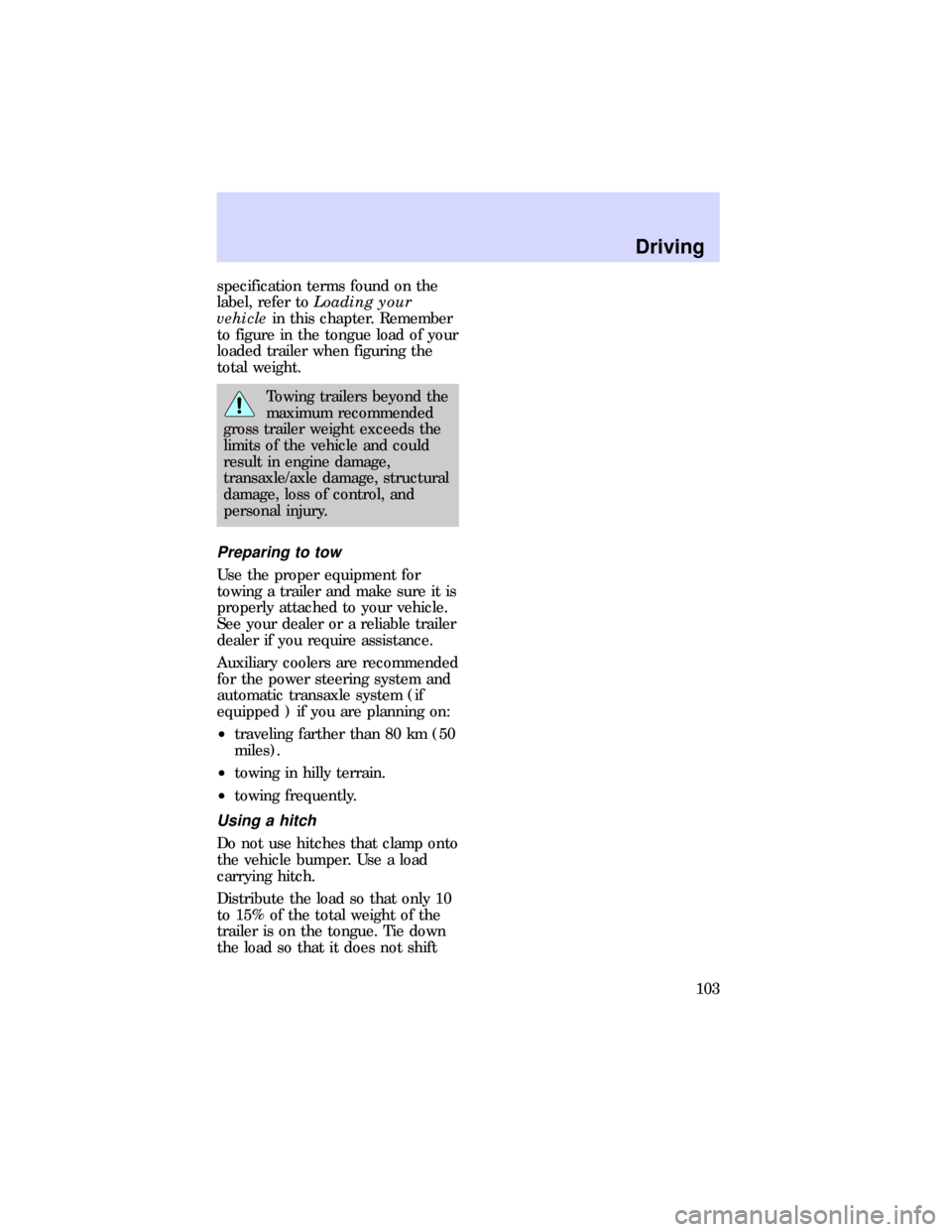Page 43 of 191
Fuel pump shut-off switch
The fuel pump shut-off switch
stops the fuel pump when the
vehicle has been involved in a
collision or substantial jolt. If the
vehicle does not start, it is possible
that the fuel pump shut-off switch
needs to be reset.
If you see or smell fuel, do
not reset the switch or try
to start your vehicle. Have all the
passengers get out of the vehicle
and call the local fire department
or a towing service.
The fuel pump shut-off switch is
located in the rear passenger side
of your vehicle. With the sedan
model, a label marks its location.
Press the button on the switch to
reset the fuel pump:
²Sedan
Controls and features
43
Page 102 of 191

²GAWR (Gross axle weight
rating)Ð carrying capacity for
each axle system (front and
rear). This amount is specific to
each vehicle and is listed on the
Safety Compliance Certification
Label on the driver's door pillar.
Payload = Gross vehicle weight
rating - Base curb weight
To obtain correct weights, try
taking your vehicle to a shipping
company or an inspection station
for trucks.
Do not use replacement tires with
lower weight capacities than the
originals because they may lower
the vehicle's GVWR and GAWR
limitations. (Replacement tires
with a higher weight limit than the
originals do not increase the
GVWR and GAWR limitations.)
If the GVWR or the GAWR
specified on the Safety
Compliance Certification Label is
exceeded, your vehicle may be
damaged or you may lose control
and cause injury.
Trailer towing
Your vehicle is capable of towing a
trailer up to 454 kg (1000 lb) gross
trailer weight with a maximum
tongue load of 45 kg (100 lb). The
trailer should have 18.6 m
2(20 ft2)
or less frontal area.
Do not exceed the maximum loads
stated on the Safety Compliance
Certification Label. For load
Driving
102
Page 103 of 191

specification terms found on the
label, refer toLoading your
vehiclein this chapter. Remember
to figure in the tongue load of your
loaded trailer when figuring the
total weight.
Towing trailers beyond the
maximum recommended
gross trailer weight exceeds the
limits of the vehicle and could
result in engine damage,
transaxle/axle damage, structural
damage, loss of control, and
personal injury.
Preparing to tow
Use the proper equipment for
towing a trailer and make sure it is
properly attached to your vehicle.
See your dealer or a reliable trailer
dealer if you require assistance.
Auxiliary coolers are recommended
for the power steering system and
automatic transaxle system (if
equipped ) if you are planning on:
²traveling farther than 80 km (50
miles).
²towing in hilly terrain.
²towing frequently.
Using a hitch
Do not use hitches that clamp onto
the vehicle bumper. Use a load
carrying hitch.
Distribute the load so that only 10
to 15% of the total weight of the
trailer is on the tongue. Tie down
the load so that it does not shift
Driving
103
Page 105 of 191

Driving while towing a trailer
Do not drive faster than 88 km/h
(55 mph) while towing a 454 kg
(1000 lb) trailer. Do not drive
faster than 72 km/h (45 mph) with
any weight trailer while towing in
hilly country or on hot days.
Speed control (if equipped) may
not work properly while towing on
very long, steep grades.
If driving with an automatic
transaxle:
²use D or L rather than
Dwhile towing up or down
steep hills.
²anticipate stops and brake
gradually.
If driving with a manual transaxle:
²select a gear that avoids jerking
or excessive engine speed.
²avoid driving excessively in first
or second gear. In first or
second gear the trailer may be
too big or too heavily loaded for
the vehicle drivetrain.
²shift to a lower gear while
towing up or down steep hills.
²anticipate stops and brake
gradually.
Servicing while towing
If you tow a trailer for long
distances, your vehicle requires
more frequent service than a
vehicle not used for towing. Refer
to theService Guidefor more
information.
Driving
105
Page 106 of 191
Towing behind a recreational
vehicle (RV)
Do not tow your vehicle behind
another vehicle, such as an RV,
unless front wheel dollies are used.
Luggage rack (if equipped)
Load luggage as far back as it will
safely go on the rack without
causing the vehicle to exceed the
gross vehicle weight rating
(GVWR) or gross axle weight
rating (GAWR).
FUEL CONSUMPTION
Fuel economy can be improved by
avoiding:
²lack of regular, scheduled
maintenance
²excessive speed
²rapid acceleration
²driving with the brake pedal
depressed
²sudden stops
²extended engine idling
²use of speed control in hilly
terrain
²extended use of the air
conditioner, defroster, rear
window defroster and other
accessories
²underinflated tires
²heavy loads
²aftermarket add-ons such as
bike, ski or luggage racks, bug
deflectors, etc.
Driving
106
Page 107 of 191
USING THE HAZARD SWITCH
Use the hazard flashers to warn
traffic of vehicle problems:
²Slide the hazard switch to the
right to activate the hazard
flashers.
²Slide the hazard switch to the
left to deactivate the
continuously blinking flashers.
RESETTING THE FUEL PUMP
SHUT-OFF SWITCH
The fuel pump shut-off switch
stops the fuel pump when the
vehicle has been involved in a
collision or major jolt. If the
vehicle does not start, it is possible
that the fuel pump shut-off switch
needs to be reset.
If you see or smell fuel, do
not reset the switch or try
to start your vehicle. Have all
passengers get out of the vehicle
and call the local fire department
or a towing service.
To reset the fuel pump, press the
button on the switch. The switch is
located immediately below the hole
in the trunk side trim.
Roadside emergencies
107
Page 123 of 191
WRECKER TOWING
If towing is necessary, it is
recommended that your vehicle be
towed with wheel lift or flatbed
equipment. Do not tow with
slingbelt equipment. Ford Motor
Company has not developed or
approved a T-hook or slingbelt
towing procedure.
Roadside emergencies
123
Page 130 of 191
CHECKING AND ADDING
ENGINE OIL
Use SAE 5W-30 motor oil
CERTIFIED FOR GASOLINE
ENGINES by the American
Petroleum Institute. Look for the
certification Ð Ford specification
WSS-M2C153-F.
Additional engine oil additives, oil
treatments, or engine treatments
are never needed and could, under
certain conditions, lead to engine
damage which is not covered by
your Warranty.
Changing the engine oil and oil
filter
Change the engine oil and oil filter
per the following, whichever
occurs first.
5,000 MILES (8,000 KM) OR 6 MONTHS
NORMAL SCHEDULE
3,000 MILES (5,000 KM) OR 3 MONTHS
SEVERE DUTY SCHEDULE
EXTENSIVE IDLING
TRAILER TOWING
DRIVING IN SEVERE DUST
POLICE, TAXI, OR DELIVERY
Oil change intervals
Refer to theService Guide
booklet for additional information.
Checking the engine oil
Check the engine oil every time
you fuel your vehicle.
Maintenance and care
130